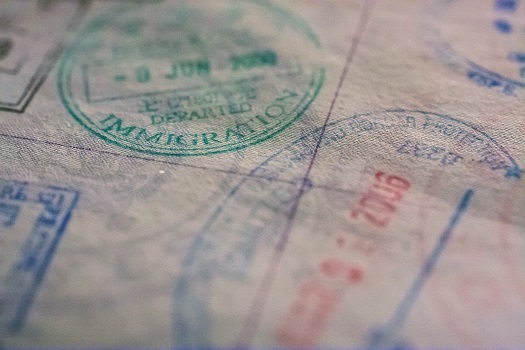IMGs face uncertainty amid politics, rhetoric
Proposed changes to U.S. immigration policy have had a ripple effect on the medical field.
The arrival of the next crop of internal medicine residents was less than two months away at Bassett Healthcare Network in Cooperstown, N.Y., when the residency program director contacted Doug DeLong, MD, FACP, in a panic.
“All of a sudden six of our 10 incoming residents in internal medicine were having their visas delayed or denied,” said Dr. DeLong, chief of the division of general internal medicine at Bassett. That holdup posed both an educational and a patient safety problem, said Dr. DeLong, who also serves as Chair-elect of ACP's Board of Regents.
“There just aren't enough bodies to do all of the work otherwise,” Dr. DeLong said. “This would have major repercussions for us.”

Bassett was among a number of residency programs reporting similar delays in the processing of H-1B visa applications, a situation that led leaders at the American College of Physicians and other physician groups to write a May 30, 2018, letter to U.S. Citizenship and Immigration Services, alerting them that the holdup could put patient care at risk. The delays, which involved a change in how federal officials reviewed wage data for the incoming residents, were resolved, and all of Bassett's residents did eventually arrive, though not necessarily by the July 1 start date, Dr. DeLong said.
The situation came amid a climate of rhetoric and potential policy changes that some worry will erode the caliber of international medical graduates (IMGs) who choose to train and sometimes stay on to practice in the United States.
Physicians, trainees, and students from certain Muslim-majority countries are particularly affected. The series of executive orders and related court decisions handed down in the last two years have created uncertainty and confusion about their ability to live and travel in the U.S.
At this point, all incoming residents are still eligible to apply for H-1B or J-1 visas, with the exception of individuals who are from Syria or who are part of the Venezuelan government, said William Pinsky, MD, president and chief executive officer of the Educational Commission for Foreign Medical Graduates. Even so, when visiting medical programs elsewhere, Dr. Pinsky has picked up on some wariness about training in the U.S.
“They still look at the United States as really the gold standard of where they would like to strive to come to for training,” Dr. Pinsky said. “But there's a ‘however.’ And the ‘however,’ when I speak with people, is they're very concerned about how welcome they will be in the country.”
A key workforce component
International medical graduates, a group that includes both people born outside the U.S. and U.S. residents or citizens who studied elsewhere, comprise about one-fourth of practicing physicians and physicians in residency training in the United States, according to an analysis published in April 2018 in the Journal of Graduate Medical Education. Among practicing physicians, IMGs make up a large portion of the physicians practicing internal medicine in the U.S. (39%), followed by neurology (31%), psychiatry (30%), and pediatrics (25%), the analysis found.
IMGs typically travel to the U.S. for residency training on an H-1B or a J-1 visa. The H-1B visa is sponsored by an employer, in this case the residency program, and those who hold it can stay in the country as long as the visa is active. Those with a J-1 visa are required to return home after training for at least two years, unless they get a waiver to serve in an underserved urban or rural area of the U.S.
In 2018, 46.4% of foreign-trained graduates—a category that includes both U.S. citizens and non-U.S. citizens graduating from international medical schools—matched in internal medicine, and 15.5% matched in family medicine, according to National Resident Matching Program data published in April 2018.
Even with the opening of new allopathic and osteopathic medical schools in recent years, the number of residency slots will continue to substantially exceed the number of U.S. medical school graduates, with a surplus of 13.5% projected by 2023-2024, according to an analysis published on Dec. 17, 2015, in the New England Journal of Medicine.
Perhaps less frequently noted is the influential role that IMGs play in academic medicine, including teaching and research, said Anupam Jena, MD, PhD, an associate professor at Harvard Medical School and a physician at Massachusetts General Hospital in Boston. Working with the database Doximity, Dr. Jena and colleagues determined that among the nearly 83,000 academic physicians in the U.S., 18.3% are IMGs, according to findings published Oct. 17, 2017, in Annals of Internal Medicine.
“Any policy that attempts to reduce immigration,” Dr. Jena said, “seems like a bad policy from the perspective of scientific development and patient care.”
Vijay Rajput, MD, FACP, who has written about his transition from India to U.S. medical practice and customs with some humor in JAMA, said there are certainly adjustments for doctors who have studied outside of the United States. For instance, physicians must learn the complexities of U.S. insurance and the often more detailed documentation required for patient care, he said.
But IMGs also bring with them a strong work ethic and commitment to practicing medicine, said Dr. Rajput, a co-editor of “The International Medical Graduate's Guide to US Medicine & Residency Training,” published by ACP in 2008, and chair of medicine at Ross University School of Medicine, which is based in Miramar, Fla., but maintains its medical sciences campus in Bridgetown, Barbados. Moreover, there's some indication, based on a JAMA study, that IMGs are less vulnerable to burnout, he said.
The analysis, which looked at burnout rates among more than 16,000 internal medicine residents, found that 45.1% of IMGs experienced burnout compared with 58.7% of U.S. medical school graduates, according to the 2011 findings. One possible explanation for the difference, the authors wrote, is that IMGs who have been able to navigate the competitive process to get into a U.S. residency program might be inherently more resilient.
Reaching underserved areas
When Dr. DeLong completed his residency at Bassett in the early 1980s, all of his colleagues were U.S. medical graduates. But the backgrounds of applicants have shifted over time, as they have at other smaller, more rurally based residency programs, he said.
The visa application holdup this past summer, as described in the letter sent by ACP, involved heightened scrutiny of the wage data incoming IMGs were providing. Federal officials had previously accepted data from the Association of American Medical Colleges but were now either asking for additional data or denying applications outright, according to the letter. (H-1B visas have been in the news recently because of concerns raised by some that companies can use them to bring in workers to fill U.S. jobs, for example in the tech field, at a lower cost.)
Physicians who want to stay in the U.S. after completing their training face other delays in the process of obtaining permanent residency, said Varun Malayala, MD, FACP, an internist practicing in Milford, Del., and a board member of the recently formed group Physicians for American Healthcare Access. Given that current immigration laws only allow 7% of the visas issued each fiscal year to be allotted to people from any one independent country, doctors from some countries that frequently train in the U.S., such as those from India, may end up waiting for decades, he said.
The nonprofit group, formed in 2018, is advocating for physicians to have a separate path for immigration, given the need for more doctors in underserved and rural areas, Dr. Malayala said. Otherwise, some of those physicians will give up on the continuing limbo and move to a country like Canada or the United Kingdom with a shorter path to residency, he said.
“It's like an ever-lasting anxiety about what the future is going to be,” Dr. Malayala said. “What's the future of their kids going to be? Can they buy a house in that community?”
Dr. Malayala recently conducted a survey that reached a total of 1,050 physicians and physician residents practicing on a visa in the U.S. According to the yet-unpublished data, slightly more than two-thirds of the respondents reported working in underserved areas. Nearly all, 96.1%, felt like they couldn't advance in their careers because of their immigration status. Nearly 80% were contemplating returning to their home country or another country because of the immigration backlog.
Future uncertainties
Dr. Pinsky is closely watching the number of applications to the residency matching program from non-U.S. IMGs, which has ticked downward a bit in the last two years, from 7,460 in 2016 to 7,067 in 2018. It's not yet clear, Dr. Pinsky said, whether that represents a statistical wobble or early signs of declining interest in U.S. training.
But perception matters, Dr. Pinsky said, as IMGs make career choices. News of a more hostile climate, such as the 2017 shooting of two Indian tech workers in a Kansas bar, can reverberate many time zones away, he said. Moreover, some IMGs worry that future travel restrictions might slow or prevent them from returning if they visit family back home, thus forcing them to live apart from loved ones during the years of their residency, Dr. Pinsky said.
He's also heard reports from some directors of small or medium-size residency programs that they're ranking applicants from Muslim-majority countries lower than they would have previously because of concerns that their arrival could be delayed or denied.
“I understand why,” Dr. Pinsky said. “In these small or medium programs, if one or two people can't get into the country, that really is a problem in terms of the program.”
But, he added, “Not only is it unfair for applicants, it also has the potential of diluting the quality of individuals in the [residency] program.”
Only time will tell if more uncertainty will curtail the number of IMGs who both train and choose to remain practicing in the United States. But if there's a dent in their numbers and practice skills, Dr. Pinsky has no doubt which patients will be impacted first. “Clearly it's going to be the underserved areas,” he said.
Charlotte Huff is a freelance writer in Fort Worth, Texas.


